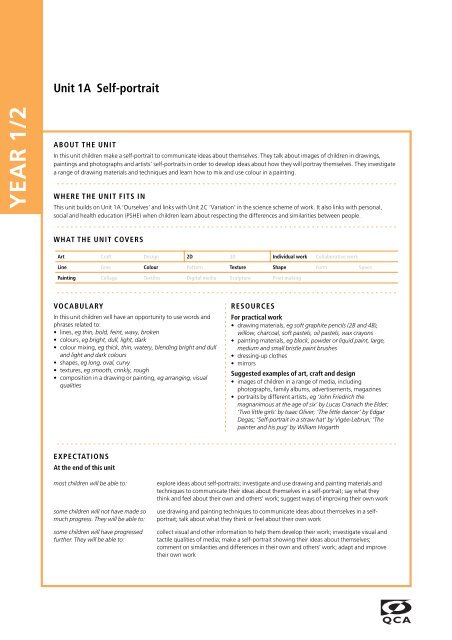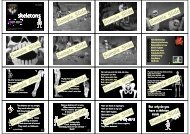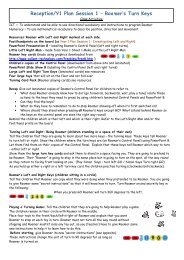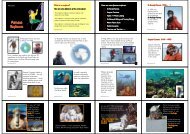YEAR 1/2 Unit 1A Self-portrait - KS1 Resources
YEAR 1/2 Unit 1A Self-portrait - KS1 Resources
YEAR 1/2 Unit 1A Self-portrait - KS1 Resources
You also want an ePaper? Increase the reach of your titles
YUMPU automatically turns print PDFs into web optimized ePapers that Google loves.
<strong>YEAR</strong> 1/2<br />
<strong>Unit</strong> <strong>1A</strong> <strong>Self</strong>-<strong>portrait</strong><br />
ABOUT THE UNIT<br />
In this unit children make a self-<strong>portrait</strong> to communicate ideas about themselves. They talk about images of children in drawings,<br />
paintings and photographs and artists’ self-<strong>portrait</strong>s in order to develop ideas about how they will portray themselves. They investigate<br />
a range of drawing materials and techniques and learn how to mix and use colour in a painting.<br />
WHERE THE UNIT FITS IN<br />
This unit builds on <strong>Unit</strong> <strong>1A</strong> ‘Ourselves’ and links with <strong>Unit</strong> 2C ‘Variation’ in the science scheme of work. It also links with personal,<br />
social and health education (PSHE) when children learn about respecting the differences and similarities between people.<br />
WHAT THE UNIT COVERS<br />
Art Craft Design 2D 3D Individual work Collaborative work<br />
Line Tone Colour Pattern Texture Shape Form Space<br />
Painting Collage Textiles Digital media Sculpture Print making<br />
VOCABULARY<br />
In this unit children will have an opportunity to use words and<br />
phrases related to:<br />
• lines, eg thin, bold, feint, wavy, broken<br />
• colours, eg bright, dull, light, dark<br />
• colour mixing, eg thick, thin, watery, blending bright and dull<br />
and light and dark colours<br />
• shapes, eg long, oval, curvy<br />
• textures, eg smooth, crinkly, rough<br />
• composition in a drawing or painting, eg arranging, visual<br />
qualities<br />
EXPECTATIONS<br />
At the end of this unit<br />
RESOURCES<br />
For practical work<br />
• drawing materials, eg soft graphite pencils (2B and 4B),<br />
willow, charcoal, soft pastels, oil pastels, wax crayons<br />
• painting materials, eg block, powder or liquid paint, large,<br />
medium and small bristle paint brushes<br />
• dressing-up clothes<br />
• mirrors<br />
Suggested examples of art, craft and design<br />
• images of children in a range of media, including<br />
photographs, family albums, advertisements, magazines<br />
• <strong>portrait</strong>s by different artists, eg ‘John Friedrich the<br />
magnanimous at the age of six’ by Lucas Cranach the Elder;<br />
‘Two little girls’ by Isaac Oliver; ‘The little dancer’ by Edgar<br />
Degas; ‘<strong>Self</strong>-<strong>portrait</strong> in a straw hat’ by Vigée-Lebrun; ’The<br />
painter and his pug’ by William Hogarth<br />
most children will be able to: explore ideas about self-<strong>portrait</strong>s; investigate and use drawing and painting materials and<br />
techniques to communicate their ideas about themselves in a self-<strong>portrait</strong>; say what they<br />
think and feel about their own and others’ work; suggest ways of improving their own work<br />
some children will not have made so<br />
much progress. They will be able to:<br />
some children will have progressed<br />
further. They will be able to:<br />
use drawing and painting techniques to communicate ideas about themselves in a self<strong>portrait</strong>;<br />
talk about what they think or feel about their own work<br />
collect visual and other information to help them develop their work; investigate visual and<br />
tactile qualities of media; make a self-<strong>portrait</strong> showing their ideas about themselves;<br />
comment on similarities and differences in their own and others’ work; adapt and improve<br />
their own work
EXPLORING AND DEVELOPING IDEAS<br />
• about differences and similarities in<br />
the work of artists<br />
• to ask and answer questions about<br />
the starting points for their work, and<br />
to develop their ideas<br />
INVESTIGATING AND MAKING<br />
• to investigate the possibilities of a<br />
range of materials and processes,<br />
including drawing<br />
• to try out tools and techniques and<br />
apply these to materials and<br />
processes, including drawing<br />
• Talk about selected images of children, raising questions about the ways in which the clothes worn, the<br />
pose and the activities shown, convey ideas about the children.<br />
• Talk about selected self-<strong>portrait</strong>s focusing on how artists have conveyed ideas about themselves, eg how<br />
do the artists show themselves? As a painter? As a mother? As a friend? As a person with status? Ask<br />
the children to suggest why <strong>portrait</strong>s are made, eg to record an important time in a person’s life, to<br />
project a powerful image of the person, to portray individuals as wealthy, knowledgeable or hard<br />
working.<br />
• Focus the children’s attention on one self-<strong>portrait</strong>. Ask them to describe:<br />
– the person or people and the objects they are holding, wearing, etc (the content, subject)<br />
– the main shapes and colours, etc in the image (the visual elements and the composition)<br />
– how the image is made. Is it a photograph? A painting? A print? (materials and processes used)<br />
– how the image makes them feel about the person portrayed. What sort of person is this? What is the<br />
person doing? What does the image tell you about the person? (the ideas and meanings)<br />
• Ask the children to look at each other’s appearance, eg their height, shape, colour of skin and hair, facial<br />
features.<br />
Talk about how the children would show themselves in a <strong>portrait</strong>. What clothes would they be<br />
wearing? How would they like to be seen? What would they be doing? Would they include objects such<br />
as toys or a pet?<br />
• Ask the children to investigate a range of drawing media and the marks they can make, eg try out<br />
techniques for showing textures of hair, smoothness of skin, pattern on clothing. Encourage children<br />
to explore different types of marks, eg bold, expressive, quiet, wriggly. Ask them to use marks that<br />
communicate ideas about themselves and how they would like to be seen by others, eg big and bold,<br />
quiet and thoughtful.<br />
• Give the children mirrors. Ask them to look at themselves and think about the size and shape of their<br />
faces and about the size of parts of their face or body in relation to each other.<br />
• Ask them to draw life-size and miniature self-<strong>portrait</strong>s, including themselves as a whole or just their<br />
head and shoulders.<br />
• to review what they have done • Display children’s work to show how they look different from one another. Put the images of children<br />
they talked about earlier alongside their work and talk about similarities and differences. Reinforce that<br />
the children can choose how to project themselves in their self-<strong>portrait</strong>s, and show themselves as they<br />
wish to be seen.<br />
• to represent observations, ideas and<br />
feelings, and design and make a<br />
painting<br />
EVALUATING AND DEVELOPING WORK<br />
• to review what they and others have<br />
done and say what they think and feel<br />
about it<br />
• to identify what they might change in<br />
their current work or develop in their<br />
future work<br />
• Using their drawings as a reference, ask the children to make a larger painting. Ask them to draw the<br />
outline and main shapes of the <strong>portrait</strong> using light-coloured chalk or a medium brush and a light colour.<br />
Show them how to mix paint and colour to represent skin, eyes, hair, etc. Demonstrate a system of<br />
colour mixing, eg combining two colours to achieve a range, adding black or white to make darker or<br />
lighter tones.<br />
• As a class, review the children’s drawings and paintings and the decisions they made. Talk about what<br />
they think has been most successful. What ideas about themselves and meanings did they want to<br />
convey? How have they represented themselves? What have they included in the <strong>portrait</strong> and why?<br />
What are they doing in their <strong>portrait</strong>? How have they used the media – drawing, paint? How have they<br />
used visual qualities such as line, colour, texture? What do they think about the techniques they have<br />
used?<br />
• Ask the children to say what they would like to change about their work and what they think they<br />
would like to do in the future. How might they show themselves differently? What characteristics might<br />
they have portrayed instead? What would they like to show in a <strong>portrait</strong> of someone else?<br />
• identify differences in ways that children are represented in art<br />
• identify ways in which artists represent themselves and suggest<br />
reasons for this<br />
• identify aspects of one self-<strong>portrait</strong> and say what they think and feel<br />
about it<br />
• identify ways in which children in the class are similar to and different<br />
from each other<br />
• suggest ideas about how to represent themselves<br />
• experiment with and use drawing media and techniques to create a<br />
range of visual effects<br />
<strong>Unit</strong> <strong>1A</strong> <strong>Self</strong>-<strong>portrait</strong><br />
• Ask the children to collect photographs and other information about<br />
themselves at home, school and play.<br />
• Display images of children by painters, photographers and<br />
illustrators (including photographs of the children in the class)<br />
together with examples of artists’ self-<strong>portrait</strong>s.<br />
• Develop strategies to give children confidence to talk about the<br />
work of artists. These could include focusing attention on one image<br />
and asking one or more children to adopt the pose of the sitter in<br />
the <strong>portrait</strong>, or using dressing-up clothes to replicate a <strong>portrait</strong>.<br />
• Links with National Literacy Strategy: Framework for teaching,<br />
year 1<br />
vocabulary extension, where children learn new words from shared<br />
experiences.<br />
• Links with <strong>Unit</strong> <strong>1A</strong> ‘Ourselves’ and <strong>Unit</strong> 2C ‘Variation’ in the science<br />
scheme of work where children learn about the similarities and<br />
differences between humans. It could also link to PSHE by helping<br />
children to learn to respect similarities and differences between<br />
people.<br />
• Explain that the purpose of the activity is to learn about different<br />
drawing media, and to investigate different kinds of marks and how<br />
they might be used in their work. It is not to produce a finished<br />
drawing.<br />
• record self-<strong>portrait</strong>s from observation, working on different scales • Teach children how to organise their workspace, including setting<br />
out and packing away materials. Encourage children to think about<br />
how to use tools and materials safely and effectively.<br />
• comment on differences in others’ work • Encourage children to experiment with mixing colour and with<br />
controlling the consistency of the paint. Show them how to apply<br />
the colour in stages, deciding which parts they will treat as flat<br />
colour and which parts they will work and make more complex.<br />
• plan, compose and make a self-<strong>portrait</strong> painting • Provide opportunities for children to discuss their plans and think<br />
through the ideas they would like to convey.<br />
• use descriptive and expressive vocabulary to talk about their <strong>portrait</strong><br />
work<br />
• identify the successful parts of their painting and explain why they<br />
think these parts are successful<br />
• identify what they might like to change or improve<br />
• Displaying children’s work can be part of the review process. It gives<br />
children the opportunity to compare their work with others in the<br />
class and can help them to learn from their successes as well as from<br />
their mistakes and difficulties.
PRIOR LEARNING<br />
It is helpful if children have:<br />
• explored ideas about themselves<br />
• used drawing media and worked from observation<br />
• talked about their drawings and paintings as they develop<br />
• looked at other artists’ work and talked about what they think or<br />
feel about it<br />
ADAPTING THE UNIT OF WORK<br />
Ref: QCA/00/439<br />
© Qualifications and Curriculum Authority (QCA) 2000<br />
FUTURE LEARNING<br />
<strong>Unit</strong> <strong>1A</strong> <strong>Self</strong>-<strong>portrait</strong><br />
In <strong>Unit</strong> 2A ‘Picture this!’, children explore an issue or event in their<br />
own lives and record their observations and ideas using a variety of<br />
media.<br />
Children could:<br />
• represent themselves by selecting and making an arrangement of the objects that they value, eg toys, clothes, books, games,<br />
recording<br />
their observations and making a painting<br />
• investigate mark-making using ICT tools, including flood fill and spray tools. They could use these effects to make <strong>portrait</strong>s showing<br />
feelings such as anger, fear or joy, building on <strong>Unit</strong> 2B ‘Creating pictures’ in the ICT scheme of work<br />
• explore the shape and form of the head, using self-hardening clay to model in three dimensions, and use their sculptures as a starting<br />
point for developing large-scale expressive <strong>portrait</strong> paintings (see Expectations in art at key stages 1 and 2, ’Faces and heads’, p14,<br />
SCAA 1997)






